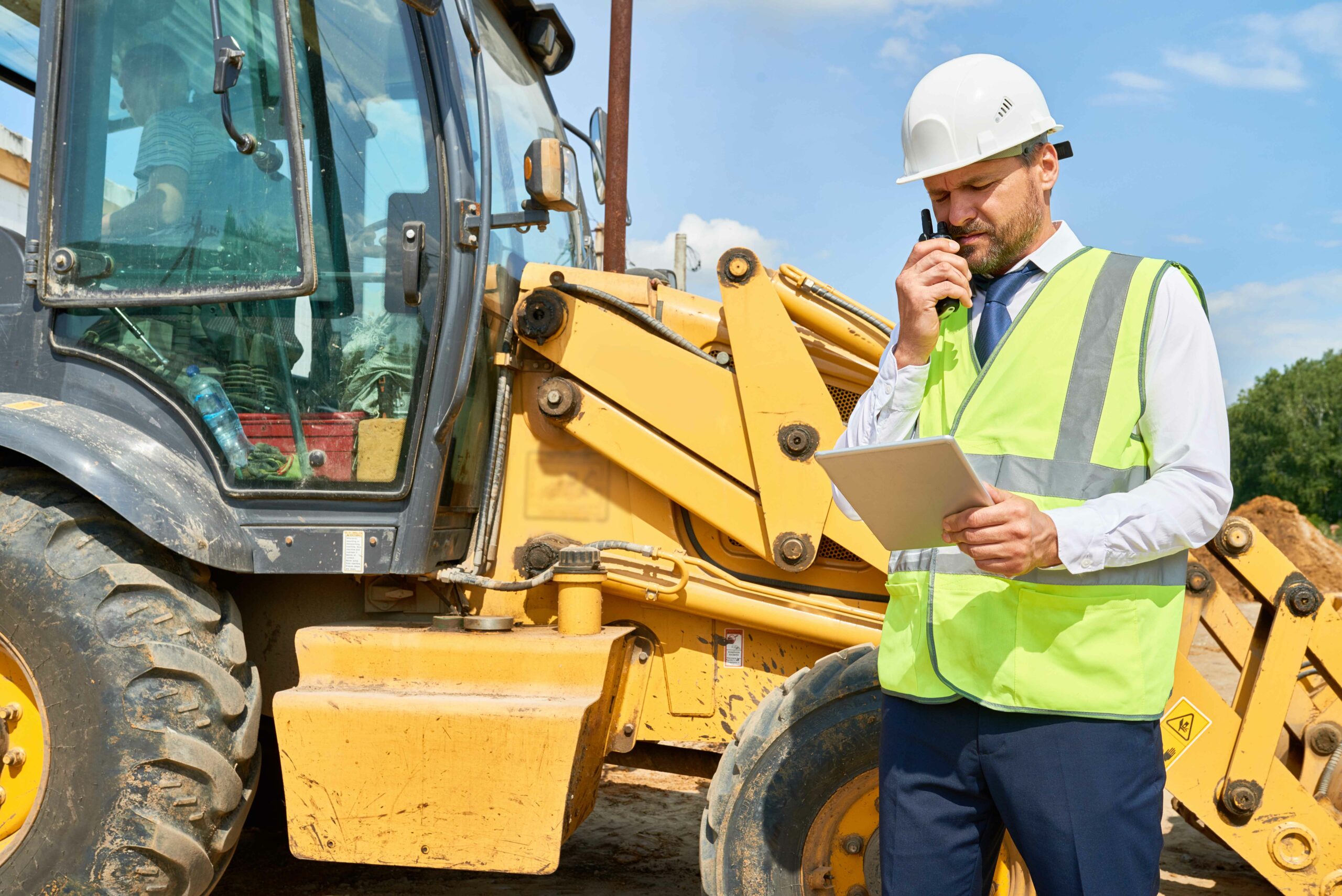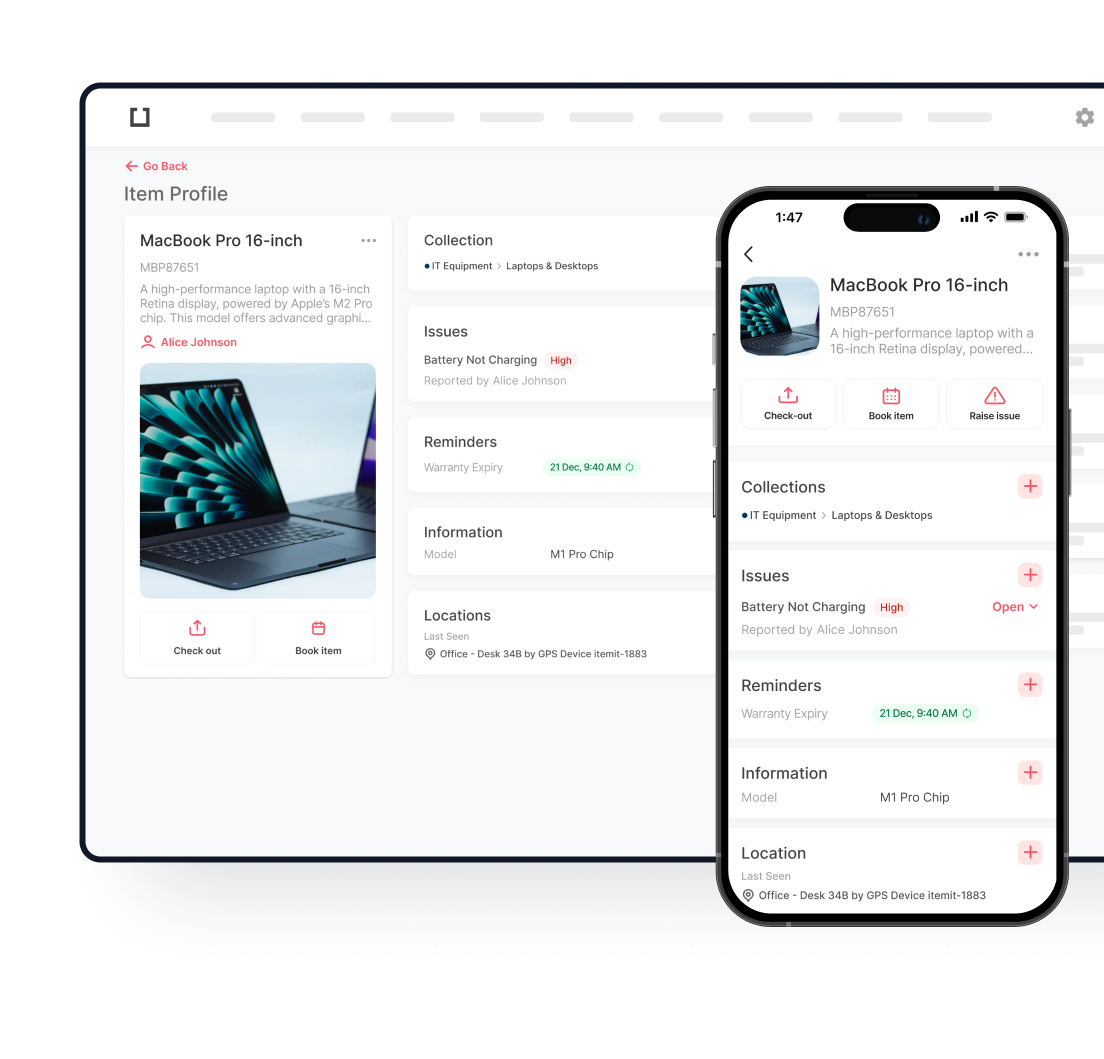
A $200,000 excavator sits unused at Site A while your crew at Site B wastes three hours waiting for one. Your fleet includes excavators, bulldozers, loaders, cranes, each machine built for specific work. The problem isn’t owning equipment. It’s knowing where everything is right now, who’s operating it, and whether it needs service. Most construction delays trace back to equipment issues: machines in the wrong place, unavailable when needed, or breaking down because nobody tracked maintenance schedules. Projects hemorrhage money when asset management fails.

Key Takeaways
Here’s what you’ll find in this guide:
- Earthmoving machines like excavators, bulldozers, and graders handle site preparation, each tackling different terrain challenges
- Material handling equipment moves resources efficiently, keeping projects on schedule
- Lifting and specialized machinery solves problems that general-purpose equipment can’t touch
- Real-time tracking systems show you exactly where equipment is and what condition it’s in
- Proactive maintenance catches problems early, saving money and preventing breakdowns
Digital management tools cut manual labor, boost accuracy, and give you better data
What Equipment Powers Earthmoving and Site Preparation?
Reshaping land demands serious machinery. Excavators come in different sizes for different jobs. Mini excavators squeeze into tight urban spaces where bigger machines won’t fit. A standard excavator handles most digging—trenches, foundations, utility line work. Need to reach across a pond or dig deeper? Long-reach models extend their boom significantly beyond standard configurations.
Bulldozers push things. That’s their job, and they do it with raw power. Crawler dozers sit on continuous tracks that spread weight across soft ground. Mud, loose soil, steep slopes—tracks handle them. Wheel dozers move faster between positions but can’t match the stability of tracked versions. That big blade up front pushes soil, debris, rocks, snow, whatever needs moving.
Here’s something practical: backhoes combine two functions in one machine. The rear excavating arm digs trenches or scoops material. The front bucket loads trucks or moves supplies around. Smaller projects often rely on backhoes because they’re versatile and cost less than buying separate machines. Tight residential sites favor them too.
Motor graders create precise slopes and smooth surfaces. Bulldozers do the heavy clearing and rough grading. Graders come behind and refine everything to exact specifications. Road construction depends heavily on these machines—proper drainage requires precise angles that only a grader’s long adjustable blade can deliver.
Project scope and ground conditions determine which machine you need. Once your fleet grows beyond a few pieces, heavy equipment tracking stops being optional. Otherwise, good luck finding the right machine when deadlines are tight.
Which Machines Handle Material Transport and Loading?
Getting materials from point A to point B eats up time on every site. Wheel loaders scoop and transport loose materials—gravel, soil, debris, sand. Bucket capacity matters here. Small loaders work fine for landscaping projects. Large-capacity models belong in mining operations or major infrastructure builds where you’re moving massive volumes.
Dump trucks haul stuff. Articulated versions bend in the middle, letting them navigate rough terrain and make tight turns. That flexibility helps on uneven sites. Rigid dump trucks carry more weight but can’t turn as sharply. Quarries and mines use them because the hauls are straight and the roads are established.
Skid steers work where space is limited. Their compact size and ability to spin in place make them perfect for interior demolition or cramped job sites. The attachment system is brilliant—swap from a bucket to an auger or trencher in minutes. One machine does multiple jobs.
Need to move earth on a massive scale? Scrapers cut, collect, and transport soil in one pass. They eliminate the need for separate excavating and hauling equipment. Big earthwork projects run more efficiently with scrapers because the machine does everything itself.
Here’s the problem: having the right equipment doesn’t help if you can’t find it. Teams waste hours tracking down machines that are sitting unused somewhere else. Projects fall behind waiting for equipment that’s actually available but nobody knows where.
What Lifting and Specialized Equipment Do Projects Require?
Vertical construction needs different machines. Tower cranes lift materials to heights that nothing else can reach. You see them on city skylines, fixed in place, reaching across building footprints. Mobile cranes trade some height for flexibility. They move around sites, between projects, setting steel beams one day and placing rooftop HVAC units the next.
Telehandlers sit between forklifts and cranes. The extendable boom reaches higher than a forklift. Big tires handle rough ground that would stop a warehouse forklift cold. Teams use them to place materials on upper floors or transfer loads from delivery trucks.
Aerial work platforms get crews up high safely:
- Boom lifts reach out and over obstacles with articulating or telescoping arms
- Scissor lifts go straight up, giving workers a stable platform for precision work
- Personnel lifts handle single-person jobs like maintenance or inspection
Concrete pumps changed how construction crews work with concrete. The articulated arm reaches over obstacles and into tight spaces. No more wheelbarrowing concrete across a site—the pump delivers it exactly where it needs to go. Large pours become manageable instead of nightmares.
Then you have specialized tools for unique problems. Rock breakers demolish concrete. Trenchers dig narrow, deep channels for utilities. Compactors prepare surfaces for paving. As your collection of specialized machines grows, you need construction management software just to keep track of everything across multiple sites.
How Does Real-Time Tracking Transform Equipment Visibility?
Construction sites cover acres, sometimes multiple locations simultaneously. Paper logs can’t keep up. GPS tracking uses satellite signals to show exactly where machines are. Pull up your laptop or phone and see your entire fleet on a map. Watch assets move in real time.
QR codes and barcodes speed up check-ins. Scan a tag, the system records who took the equipment and when. Seconds, not minutes. No forms, no filing. The system builds an audit trail automatically.
RFID tags work without scanning. Equipment passes through checkpoints, readers capture data automatically. High-traffic areas benefit most—manual scanning would create bottlenecks.
Geofencing draws invisible boundaries around job sites. Equipment crosses the line, you get an alert immediately. Catches theft attempts fast. Some companies using construction equipment management software report recovering stolen assets within hours instead of never seeing them again.
Mobile apps put all this data in field supervisors’ hands. Check equipment status from anywhere. No need to drive back to the office. Operators can locate available machines and reserve them for upcoming work. Real-time visibility prevents double-booking.
GPS equipment monitoring also tracks utilization. Which machines run constantly? Which ones sit idle? Hard data guides purchasing decisions and shows when you should move underused equipment to busier sites. Real time asset management replaces guessing with facts.
Construction inventory tracking covers more than big machines. Hand tools, generators, safety gear—everything gets tagged. Tool boxes, individual items, attachments. Digital records create accountability. Losses become obvious quickly instead of going unnoticed for months.

Why Does Construction Equipment Maintenance Demand Consistent Attention?
Machines break. The only question is whether they fail on your schedule or theirs.
Preventive maintenance follows manufacturer guidelines. Service equipment at specific intervals based on operating hours or calendar time. Oil changes, filter replacements, inspections happen before anything breaks. Costs money upfront. Prevents disasters later.
Reactive maintenance waits for failures. Fix things only when they stop working. Seems cheaper at first—why spend money if nothing’s broken? Then a hydraulic line ruptures on your critical excavator during a big pour. The entire project stops. Emergency repairs cost triple. You learn the hard way.
Common problems show up across equipment types. Hydraulic systems leak. Tracks wear from abrasive soil. Engines fail from dirty filters or poor lubrication. Electrical systems corrode in weather. Preventative maintenance catches these during routine inspections before they become catastrophic.
Documentation separates professional operations from amateur ones. Every service gets recorded. Maintenance history on each machine. When you sell equipment, complete records bring higher prices. Warranty claims need proof you maintained things properly. Insurance investigators check maintenance records after accidents.
Operators matter more than most companies realize. Good operators hear unusual noises, notice sluggish response, spot fluid leaks. They check machines daily before starting work. Bad operators overload equipment, ignore warning lights, miss obvious problems. The most expensive excavator becomes junk in careless hands.
Construction equipment maintenance works better when software automates scheduling. Systems track actual usage hours and send reminders when service comes due. Turns maintenance from reactive scrambling into routine management.
How Can Digital Systems Reduce Manual Equipment Management?
Spreadsheets worked when fleets were small. They fail when operations grow. Ten machines? Maybe you can track them manually. Fifty machines across three sites? No chance.
Centralized databases give everyone access to current information. No more outdated spreadsheets bouncing around in emails. No more “I thought Mike updated that last week.”
Automated reminders handle maintenance scheduling. Monitor engine hours and calendar dates. Alert managers when service windows approach. Nothing falls through the cracks during busy periods when you’re juggling multiple deadlines.
Usage analytics show patterns you’d never spot manually. Digital systems track and analyze:
- Equipment utilization rates across different job sites
- Maintenance costs per machine showing which assets drain budgets
- Operator performance revealing who handles equipment properly
- Idle time indicating underused assets that could be redeployed
- Fuel consumption patterns highlighting inefficiencies
Check-out workflows create accountability. Someone takes equipment, the system records it. Machine comes back damaged? You know who had it. This transparency cuts down on careless handling.
Custom fields adapt to your operation. Serial numbers, warranty dates, tire sizes, fuel types, insurance policies—everything has a place. Attach manufacturer manuals and parts diagrams directly to equipment records. Teams access information instantly instead of digging through file cabinets or calling the office.
Integration with project management systems closes gaps. Assign equipment to a project, both systems update automatically. Equipment costs flow to the right budget codes. Real time asset management connects machine usage to financial performance.
Bulk operations save massive amounts of time. Moving ten machines between sites? A few clicks instead of updating each one individually. Changing service intervals across similar equipment? Update them all at once. Construction inventory tracking becomes manageable instead of overwhelming. Construction equipment maintenance schedules update in batches when procedures change.
What Role Does Asset Management Software Play in Streamlining Operations?
Multiple job sites create visibility nightmares. Equipment sits unused at Site A while crews at Site B waste time waiting for machines. itemit solves this with cloud-based tracking accessible anywhere. One dashboard shows your complete fleet across all locations.
QR code scanning makes updates instant. Field teams use phones to scan equipment tags. Location changes, condition notes, completed maintenance—all recorded immediately. The mobile app works offline too. Data syncs when connectivity returns. Remote sites with spotty cell service? No problem.
Bulk operations change everything for large fleets. Twenty machines moving between sites? Update them simultaneously. Assigning an entire equipment category to a new project? Done in clicks. What used to take hours takes minutes.
Automated reporting eliminates busywork. Utilization reports show which machines work hard and which collect dust. Maintenance reports highlight upcoming service needs. Depreciation reports track asset values. These insights generate automatically instead of requiring someone to compile spreadsheets.
Accuracy improvements prevent duplicate purchases. Search the system before ordering equipment. Discover you already own what you need at another location. This alone pays for the software—one prevented purchase can cover years of subscription costs.
Labor cost reductions come from multiple sources:
- Dramatically less time searching for missing equipment
- Fewer phone calls between sites checking availability
- Reduced paperwork for check-outs and maintenance logs
- Automated reminders replacing manual tracking calendars
Custom fields capture everything specific to your operation. Manufacturer specs, warranty expiration dates, service intervals, operational requirements. Photos of equipment condition, purchase invoices, insurance certificates. Everything relevant to each asset lives in one searchable place.
Equipment monitoring through itemit transforms how you operate. Asset tracking software becomes the foundation for construction inventory tracking that actually functions. Stop wondering where equipment is. Know. Stop hoping maintenance happens. Ensure it. Stop accepting losses as inevitable. Prevent them.
Visibility extends to items often overlooked. Hand tools, safety equipment, accessories—all get tags and tracking. Accountability improves across the organization. Losses drop. Employees treat equipment better when they know the system tracks everything back to them.

Your Next Steps
Construction equipment comes in dozens of varieties because construction projects throw different challenges at you. Excavators, loaders, cranes, specialized machines—each solves specific problems. But owning equipment is half the equation.
Knowing where machines are, how they’re performing, and when they need attention completes it. Technology makes detailed equipment management practical for operations of any size. GPS tracking, mobile scanning, automated reminders—these tools eliminate the manual burden that once made comprehensive tracking impossible for smaller companies.
Projects succeed when the right equipment shows up at the right place in working condition. This doesn’t happen by luck. It results from systems that track assets, schedule maintenance, and provide visibility across your entire operation. Construction equipment maintenance, real-time monitoring, and inventory tracking work together protecting investments worth millions. Companies embracing these tools gain advantages through reduced downtime, lower costs, and better project delivery. Your competitors are already doing this. Catching up starts now.

Try itemit
Choose a better way to track
your assets.
Start your free 14-day trial now!
Frequently Asked Questions
What's the difference between preventive and reactive maintenance for construction equipment?
Preventive maintenance services equipment on scheduled intervals following manufacturer recommendations, catching problems before failures occur. Reactive maintenance responds only after breakdowns happen, usually resulting in higher costs, project delays, and more extensive repairs.
How does GPS tracking help prevent equipment theft on construction sites?
GPS establishes virtual boundaries around authorized locations and triggers instant alerts when equipment moves outside designated zones. Real-time location data enables quick response to theft and helps recover stolen assets before they disappear.
Can small construction companies afford asset tracking technology?
Cloud-based systems scale to any fleet size with subscription pricing that matches your operation. The payback comes fast—preventing one stolen excavator typically covers years of tracking costs.
How long does it take to implement an equipment management system?
Modern cloud systems go live within days, not weeks. Setup time depends on fleet size and historical data you’re importing, but basic tracking starts immediately after tagging equipment.
What data should I track for each piece of equipment?
Start with location, operator assignment, maintenance history, usage hours, and manufacturer specs. Add purchase date, warranty information, insurance details, fuel type, and compatible attachments as needed.

Keep Learning
itemit Blog
Tips, guides, industry best practices, and news.
How to Create an Effective Construction Management Plan for Your Project
Create an effective construction management plan that improves safety, minimises delays and keeps your project organised and on track from planning to completion.
A Complete Guide to Construction Cost Management and Planning
Effective construction cost management and planning improve profitability, enhance financial stability, and strengthen resource allocation across every project.
Key Strategies for Successful Construction Business Development
Smart strategies for construction business development that help attract clients, increase project success, and drive sustainable growth in a competitive market.



